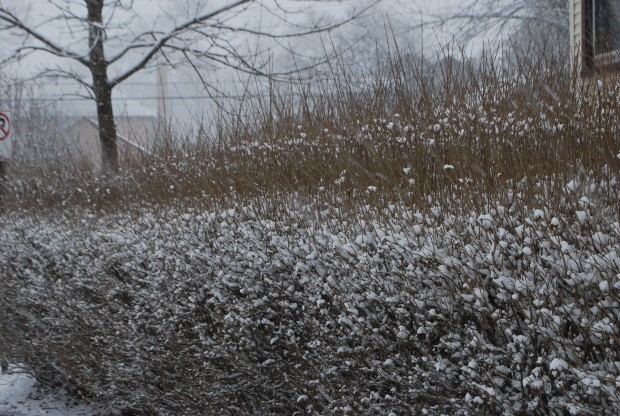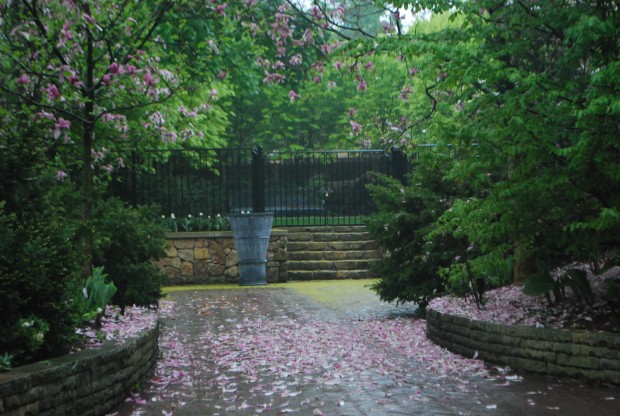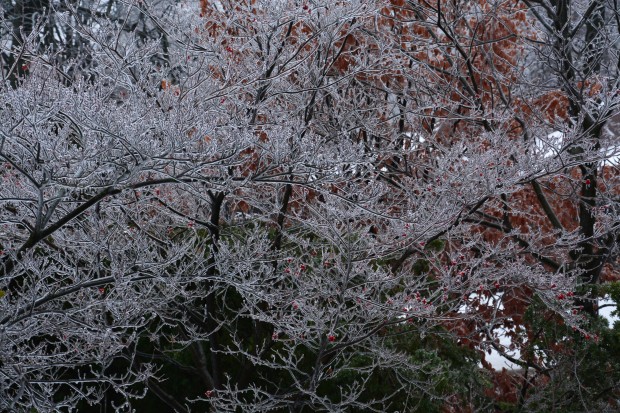 It doesn’t seem possible that almost 365 days have gone by since I took this picture in January of 2012. I recollect that we had almost nothing in the way of snow cover last winter; this modest January snow was a welcome relief from the winter grays. But what interested me most was how the snow illustrated the pruning practices of this particular gardener. This privet hedge has been sheared flat, and just above the previous year’s growth, for at least the past 3 years. It is a paradox, or at the least ironic, that pruning a branch results in a proliferation of growth via multiple shoots at the site of the cut. Eventually this yearly shearing will result in a mass of shoots on top so dense that light and air cannot penetrate to the interior. A hedge deprived of light and air to the interior will decline. I try to prune my deciduous hedges to look like a slice of swiss cheese. In and out, low and high-plenty of places for light to penetrate. Although I shouldn’t presume a gardener is in charge here, even the most experienced gardener makes pruning cuts that they wish they hadn’t. A slight snow in January will tell all.
It doesn’t seem possible that almost 365 days have gone by since I took this picture in January of 2012. I recollect that we had almost nothing in the way of snow cover last winter; this modest January snow was a welcome relief from the winter grays. But what interested me most was how the snow illustrated the pruning practices of this particular gardener. This privet hedge has been sheared flat, and just above the previous year’s growth, for at least the past 3 years. It is a paradox, or at the least ironic, that pruning a branch results in a proliferation of growth via multiple shoots at the site of the cut. Eventually this yearly shearing will result in a mass of shoots on top so dense that light and air cannot penetrate to the interior. A hedge deprived of light and air to the interior will decline. I try to prune my deciduous hedges to look like a slice of swiss cheese. In and out, low and high-plenty of places for light to penetrate. Although I shouldn’t presume a gardener is in charge here, even the most experienced gardener makes pruning cuts that they wish they hadn’t. A slight snow in January will tell all.
 February is typically a very snowy month in my zone. That snow cover is insulation against temperature extremes that can heave plants out of the ground . A February with no snow is a worry. Plants go dormant for the winter, in order to avoid injury. A cover of snow keeps my plants snugly dormant. No unwanted mid winter wake up. Given how brutal our winters can be, I favor plants that are tolerant of a wide range of winter conditions. I save my lust for plants not hardy in my zone for my containers-so much less heartbreak.
February is typically a very snowy month in my zone. That snow cover is insulation against temperature extremes that can heave plants out of the ground . A February with no snow is a worry. Plants go dormant for the winter, in order to avoid injury. A cover of snow keeps my plants snugly dormant. No unwanted mid winter wake up. Given how brutal our winters can be, I favor plants that are tolerant of a wide range of winter conditions. I save my lust for plants not hardy in my zone for my containers-so much less heartbreak.
 This March I did some major pruning. Jack from Guardian Tree in Ann Arbor headed back my out of control Princeton Gold maples. He topped my arborvitae at 14 feet. And he removed an old maple in serious decline from girdling roots. Years ago I planted parrotias and magnolias around this maple, knowing the day would come when it would no longer be viable. I was glad not to have to watch large portions of the the tree fail to leaf out. The understory trees will thrive, given more light, and better access to water and nutrients.
This March I did some major pruning. Jack from Guardian Tree in Ann Arbor headed back my out of control Princeton Gold maples. He topped my arborvitae at 14 feet. And he removed an old maple in serious decline from girdling roots. Years ago I planted parrotias and magnolias around this maple, knowing the day would come when it would no longer be viable. I was glad not to have to watch large portions of the the tree fail to leaf out. The understory trees will thrive, given more light, and better access to water and nutrients.
 April is all about the spring light. Not so warm, this light, but there is the promise of the gardening season to come. The maples leafed out with abandon. Jack had cut the maples back so hard I was worried it would be years before they looked good. My worries were unfounded. He will be back this coming March. The maintenance of a hedge of trees requires a regular commitment. In April I was glad I had gone ahead and had the trees pruned.
April is all about the spring light. Not so warm, this light, but there is the promise of the gardening season to come. The maples leafed out with abandon. Jack had cut the maples back so hard I was worried it would be years before they looked good. My worries were unfounded. He will be back this coming March. The maintenance of a hedge of trees requires a regular commitment. In April I was glad I had gone ahead and had the trees pruned.
 Late April belongs to the magnolias. The bark, the sculptural habit, and large glossy leaves would be enough to include them in any small garden, but the flowers are swoon worthy. This April day, the green maple flowers and magnolia petals peppered the driveway. I parked in the street. This was a perfect early spring moment.
Late April belongs to the magnolias. The bark, the sculptural habit, and large glossy leaves would be enough to include them in any small garden, but the flowers are swoon worthy. This April day, the green maple flowers and magnolia petals peppered the driveway. I parked in the street. This was a perfect early spring moment.
 In May, the garden sings. Every plant is covered with fresh new growth. The grass is green beyond green. A pair of old Palabin lilacs on standard flower as if they were young bucks. The gorgeous shades of green is the story of the May garden. There is no garden marvel quite like the spring. All of that will to grow that results in so much fresh growth is energizing. Spring is the best tonic any gardener could hope for. Late May-the peony buds swell and open-operatic.
In May, the garden sings. Every plant is covered with fresh new growth. The grass is green beyond green. A pair of old Palabin lilacs on standard flower as if they were young bucks. The gorgeous shades of green is the story of the May garden. There is no garden marvel quite like the spring. All of that will to grow that results in so much fresh growth is energizing. Spring is the best tonic any gardener could hope for. Late May-the peony buds swell and open-operatic.
 June is the time that the roses hold forth. I would not do without them, no matter how small my garden. Some years are better than others, but they always enchant me. The color and the perfume-heavenly. My roses have grown in this spot for 15 years or better. The most I do is to prune in April, and July, and I dead head until mid-August. I do not mind the fussing. They reward me many times over. My little urban garden-infused with romance in mid June.
June is the time that the roses hold forth. I would not do without them, no matter how small my garden. Some years are better than others, but they always enchant me. The color and the perfume-heavenly. My roses have grown in this spot for 15 years or better. The most I do is to prune in April, and July, and I dead head until mid-August. I do not mind the fussing. They reward me many times over. My little urban garden-infused with romance in mid June.

In July, the roses are still representing. The big pot has been planted, and the boxwood has been pruned. Every day the four of us go to the rose garden. The corgis know exactly what I mean when I say “Let’s go see the roses”. They get there long before I do. I treasure the late day in this garden. The temperature has cooled off. The arborvitae shield the hot summer sun. I am done working for the day. This is my idea of a garden which is a sanctuary.
 In late July, the Limelight hydrangeas come into bloom. Though we had a cold and rainy summer that was not so friendly to my container plantings, the hydrangeas were stellar. They were laden with flowers. The foliage was a very healthy green. The herniaria carpeting the ground plane of this garden loved the cool and rainy summer.
In late July, the Limelight hydrangeas come into bloom. Though we had a cold and rainy summer that was not so friendly to my container plantings, the hydrangeas were stellar. They were laden with flowers. The foliage was a very healthy green. The herniaria carpeting the ground plane of this garden loved the cool and rainy summer.
 August was notable for the street trees that were cut down by the city. They were rotted and hollow-I worried they would fall and hurt someone. As sure as I was that they needed to come down, I regretted their demise. Big trees are a treasure-their loss is not to be taken lightly.
August was notable for the street trees that were cut down by the city. They were rotted and hollow-I worried they would fall and hurt someone. As sure as I was that they needed to come down, I regretted their demise. Big trees are a treasure-their loss is not to be taken lightly.

September was a great month for my garden. My container gardens finally picked up speed. The weather cooled. The grass grew like crazy.
 October-one realizes the garden is waning. The season will come to a close. Parting from the garden is hard.. Buck shut down the fountain in mid October-over my protests. I did not want to let go. He knows when it is time to say goodby. How the moss grew in the still water!
October-one realizes the garden is waning. The season will come to a close. Parting from the garden is hard.. Buck shut down the fountain in mid October-over my protests. I did not want to let go. He knows when it is time to say goodby. How the moss grew in the still water!
 Early December-an ice storm. The ice coating every surface is beautiful, and alarming. There was nothing to be done, except to hope for the best, and endure. No matter my worries, plants do a good job of protecting themselves from harm. They have lots of coping mechanisms for which I am grateful. So many things that govern a garden are out of my hands. But in the end, the will to live and prosper is a powerful force indeed.
Early December-an ice storm. The ice coating every surface is beautiful, and alarming. There was nothing to be done, except to hope for the best, and endure. No matter my worries, plants do a good job of protecting themselves from harm. They have lots of coping mechanisms for which I am grateful. So many things that govern a garden are out of my hands. But in the end, the will to live and prosper is a powerful force indeed.
 This gardening year may not have been my most favorite ever, but I appreciate what I had. There is much to learn and live by, via the garden.
This gardening year may not have been my most favorite ever, but I appreciate what I had. There is much to learn and live by, via the garden.